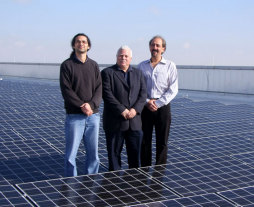
Solar technology: Seeking peak performance

From left, Cihan Tepedelenlioglu, Andreas Spanias and George Maracas will conduct research aimed at optimizing the performance of photovoltaic technology. Photo: Jessica Slater/ASU
February 16, 2010
Three faculty members in Arizona State University’s Ira A. Fulton Schools of Engineering are leading a project to improve the effectiveness of solar energy technology.
Arizona Public Service Co., the state’s largest utility company, is providing its STAR (solar technology and research) center in Tempe as an experimentation and test site.
Cihan Tepedelenlioglu, George Maracas and Andreas Spanias are using the research capabilities of the university’s Sensor, Signal and Information Processing (SenSIP) Industry Consortium – which focuses on technologies for digital signal processing systems, data mining, wireless communications, information networks and multimedia systems.
They’re exploring the application of sensor and signal information processing to methods of analyzing, measuring and testing the performance of arrays of photovoltaic modules used to produce electrical energy from sunlight.
The researchers are performing sophisticated monitoring to gather some of the most detailed technical data yet available on the factors that determine the performance of photovoltaic arrays.
Such advanced data will provide groundwork for developing more efficient, reliable and secure solar energy generation facilities, says Spanias, SenSIP’s director.
Spanias is co-directing the project with research professor George Maracas. Associate professor Cihan Tepedelenlioglu is the lead director. Each is on the faculty of the School of Electrical, Computer and Energy Engineering.
They will devise the sensor and information processing systems to detect and analyze how solar technology performs under a variety of situations, particularly changing atmospheric and weather conditions.
“The tools we have can give us the most data-rich and detailed understanding of how photovoltaic arrays are functioning, and to what extent operational and environmental conditions affect performance,” Maracas explains.
These efforts also complement research at ASU being funded through Science Foundation Arizona on a photovoltaic module laboratory and field testing of photovoltaics, Maracas adds.
Successful research results would enable utilities and solar power generating operations to forecast potentially disruptive situations and implement strategies to cope with difficulties, he says.
“If we can use our tools to devise algorithms that significantly improve the performance of photovoltaic installations,” Spanias says, “the result could be a major advance that would spur quicker adoption of renewable energy sources.”
SenSIP works with technologies encompassing a broad range of applications in security and defense, consumer electronics, medicine and health care, computer software systems, media technology, nanotechnology, environmental management, global positioning systems and antenna systems.
The consortium is under consideration to be designated a National Science Foundation industry/university collaborative research center. Its industry partners include such major companies as Raytheon Missile Systems, Intel Corporation, Lockheed Martin, National Instruments and Acoustic Technologies.
For more information, see the SenSIP web site at: https://sensip.engineering.asu.edu/.
View the latest SenSIP brochure at: http://enpub.fulton.asu.edu/sensip/IC-SenSIP/files/BROCHURE-IC.pdf.



































